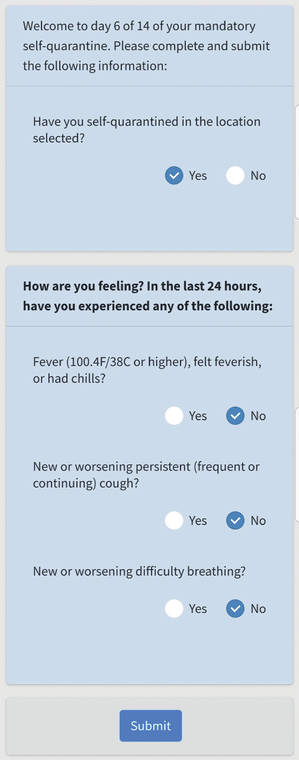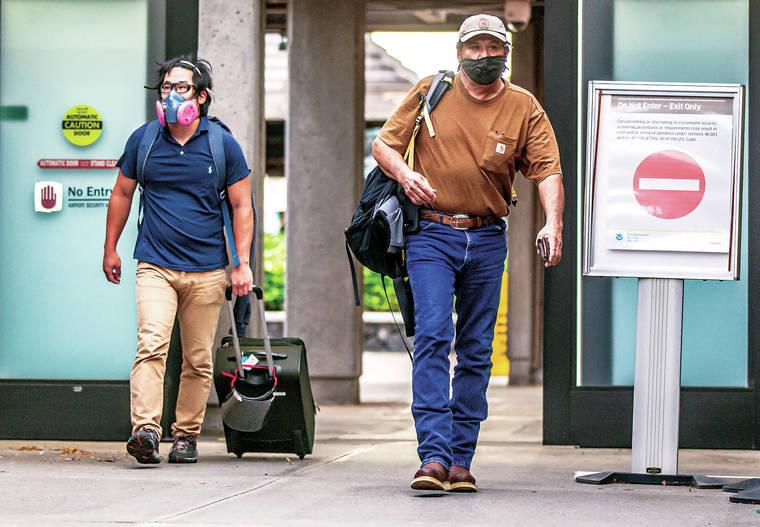Hawaii’s traveler quarantine has been touted repeatedly as a significant reason the state has contained the coronavirus more effectively than any others in the nation.
Four months after its implementation in late March, however, some cracks have shown, with residents and leaders alike voicing concern about the quarantine’s ability to be enforced.
Though the quarantine was initially effective in reducing the number of travelers to the state to a manageable number — total passengers to the islands dropped by nearly 99% in April compared to 2019 — that effectiveness has waned as the pandemic continues.
Thus far in July, more than 40,000 passengers have arrived from the U.S. mainland: a reduction of 93% from a year ago. This includes more than 100 travelers per day, on average, landing on the Big Island.
The increases have stretched the small team that works to monitor those in quarantine.
While a July 17 statement from Gov. David Ige’s office announced a team of 80 workers had made more than 113,000 contacts via calls, texts and emails to travelers who were in quarantine, the total number of mainland travelers under quarantine during that time was more than 108,000, according to the state Department of Business, Economic Development and Tourism’s visitor statistics.
That equates to an average of barely one contact per traveler, lending credibility to the concern many Hawaii residents have when they question just how effective the state’s enforcement of the quarantine truly is.
One recent traveler was Joy Johnson, a Kona resident who made the trip to the mainland for the birth of a grandchild. Upon returning, Johnson received only two texts monitoring her quarantine.
“Nothing else,” said Johnson. “I am shocked; it’s no wonder that visitors are coming.”
Since June 10, 12 attorney general law enforcement agents have made daily face-to-face visits that add up to more than 350 in-person checks of quarantined travelers, according to Paul Jones, deputy chief special agent for the state Department of the Attorney General Investigations Division.
This number represents a small fraction of the more than 66,000 mainland travelers to Hawaii in that time, and only covers Oahu.
When it comes to in-person checks, a stark divide appears between the Big Island and Oahu. While the state conducts face-to-face visits on Oahu, enforcement falls solely to the Hawaii Police Department on the Big Island.
“In the event a traveler does not respond to calls/texts, then we are notified to conduct a physical check of the traveler,” said Hawaii County Police Chief Paul Ferreira. “We also follow up on calls from the community reporting violations of the quarantine by visitors or residents. Additionally, we (began) doing random physical checks of travelers.”
As of July 18, the Big Island police department had made 99 of the state’s 182 recorded arrests of quarantine violators since the quarantine was implemented at the end of March.
On a per-traveler basis, the Hawaii Police Department has averaged one arrest per 54 travelers to the Big Island, compared to the AG’s one arrest per 2,575 travelers to Honolulu since June 10.
Oahu’s exact figures regarding quarantine enforcement are uncertain, as Honolulu police do have the ability to arrest quarantine violators but do not release numbers of COVID-related arrests. Their arrest logs, however, show few of those arrests being made.
When it comes to daily monitoring of those in quarantine, Hawaii County Civil Defense is part of the statewide task force trying to keep in touch with each traveler. For those on the Big Island, contact from the state COVID-19 Quarantine Enforcement Task Force typically includes little more than a handful of phone calls or texts.
For visitors, there’s a daily online check-in, where questions including “Have you self-quarantined in the location selected?” and “How are you feeling?” are asked. Given that most of these travelers will not be contacted in person during their stay, the state’s quarantine enforcement appears to depend overwhelmingly on trust.
According to a July 14 survey from the University of Hawaii Public Policy Center, a majority of Hawaii residents do not return the sentiment, displaying mixed trust in their government’s handling of the pandemic.
More than a quarter of Hawaii residents claimed they had little to no trust in the state/local government’s ability to keep the public safe; 61% of responders claimed they somewhat trusted the government and just 10% of the responders showed strong trust.
In particular, more effective quarantine enforcement was cited as a top answer when asked “What we could have done better.”
As the number of mainland travelers to the islands increases, up to more than 1,800 per day in July from April’s daily average of 332, those tasked with monitoring people in quarantine are becoming stretched thinner and thinner.
When asked about the increasing passenger count causing a potential strain on its team, the state attorney general’s office declined to comment.
Ferreira noted that while Hawaii County has been the most effective in catching violators, the added responsibility of catching quarantine violators in itself is a strain on the department’s resources.
“This has added yet another unanticipated challenge for our limited resources,” Ferreira said. “This is a norm for first responders: having to deal with emergency situations and ensuring we adapt our resources to address any issues that arise.”
Email Tom Linder at tlinder@westhawaiitoday.com.









